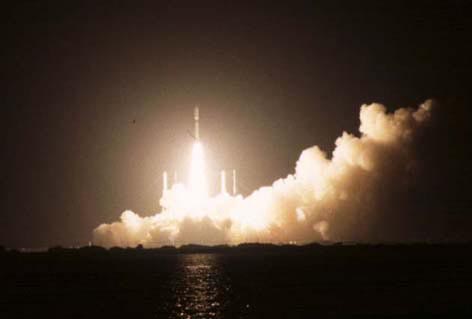
J. Brit. Astron. Assoc., 107, 6, 1997, p.338

Scientists at NASA and the European Space Agency are celebrating the successful launch on Wednesday October 15 of the Cassini mission to Saturn and Titan. After a delay from Monday in the same week, caused mainly by doubtful weather, the Titan IVB/Centaur launch vehicle blasted away from Cape Canaveral air force base at 04.43 local time following a flawless countdown. A NASA spokesman described the launch as 'picture-perfect'. Two hours later a jubilant Richard J. Spehalski, Cassini program manager at JPL, told a press conference at the Kennedy Space Center that the energy provided to the spacecraft by the launch vehicle was accurate to within one part in 5,000. The angular deviation in the trajectory was described as 'insignificant' at better than 0.004 degrees. Mission plans called for an expected adjustment in Cassini's post-launch trajectory of about 26 metres per second, but flight data shows a mere one metre per second adjustment will be required in Cassini's first scheduled trajectory correction manoeuvre. Fuel saved at this stage of course remains available for any additional corrections that may be needed later - or in the best result, for extra orbits and flybys of Saturn and its moons. 'The spacecraft is extremely clean and mission operations are proceeding in an excellent manner,' said Cassini deputy program manager Ronald Draper two days later.
Nick James and I watched the launch from a special site arranged for the Press on the shore of the Banana River, on the NASA Causeway about four miles south of Cape Canaveral's Launch Complex 40. Conditions were superb: a gentle warm breeze (short-shirtsleeve weather at three o'clock in the morning!), a clear moonlit sky, and an uninterrupted view across the water to the brightly floodlit launching site. The familiar NASA-accented tones of the pre-launch commentary echoed along the shore. The previous Monday, we had been quickly bussed out of here when it seemed the wind might change and carry dangerous fumes from the launch in our direction; but this morning everything proceeded calmly, system checks completed with no anomalies, and the final weather checks gave no cause for concern. For this launch, weather was unusually critical: unlike the Space Shuttle, which is relatively safe, the Titan IV uses poisonous hydrazine fuel, and safety considerations in the event of a hypothetical launch mishap were very strict - there must be no possibility of debris spreading over populated areas of Florida if the craft had to be destroyed. Changing upper altitude winds caused Monday morning's launch to be scrubbed for this reason, but now the controllers were satisfied. With no unplanned holds or delays the Titan's engines roared into life, and Cassini was on its way. Forty-two minutes later, final separation from the Centaur stage occurred on schedule, and as the commentator succinctly put it, 'Cassini has left the planet.'
Cassini is the most ambitious planetary exploration program yet for NASA/JPL and the European Space Agency. The spacecraft stands 6.8 metres high, with a mass of 5655kg (including the probe and on-board propellant). To reach Saturn in July 2004, the craft will execute two gravity-assist flybys of Venus (April 1998 and June 1999), and then one each of Earth (August 1999) and Jupiter (December 2000). On arrival at the Saturn system, braking manoeuvres will place the spacecraft in the first of some five dozen orbits around the planet. In November 2004, the orbiter will adjust its trajectory and release the European-built Huygens probe for the three-week coast to Titan. Huygens carries no propulsion of its own, and relies entirely on an accurate deployment. On reaching Titan, Huygens will descend by parachute for 21/2hrs to the surface of the satellite. During the descent the atmosphere will be sampled and analysed, and image data returned. If it survives, the probe will continue to transmit after reaching the surface. Dr John Zarnecki of the University of Kent at Canterbury is leading the team studying the surface properties of Titan. Other Titan investigations include temperature and composition measurement of clouds, gases and aerosols in the atmosphere, study of winds during the Probe descent, and a study of the physical and electrical properties of the atmosphere.
The Cassini orbiter will remain in the Saturn system for a planned mission duration of four years, during which it will relay back data from the magnetosphere, the icy satellites, the ring system, and of course the planet itself.
Return to Journal 1997 December contents page